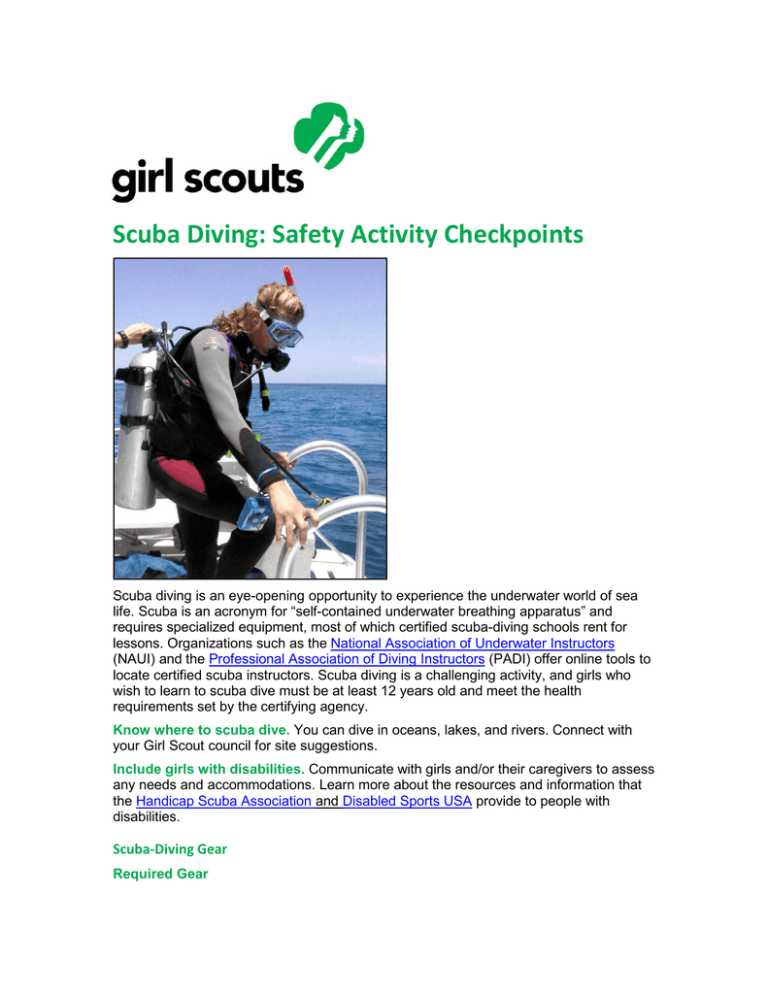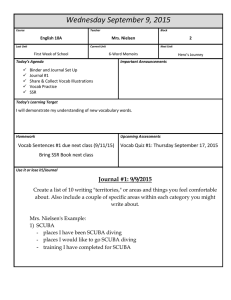Scuba Diving: Safety Activity Checkpoints
advertisement

Scuba Diving: Safety Activity Checkpoints Scuba diving is an eye-opening opportunity to experience the underwater world of sea life. Scuba is an acronym for “self-contained underwater breathing apparatus” and requires specialized equipment, most of which certified scuba-diving schools rent for lessons. Organizations such as the National Association of Underwater Instructors (NAUI) and the Professional Association of Diving Instructors (PADI) offer online tools to locate certified scuba instructors. Scuba diving is a challenging activity, and girls who wish to learn to scuba dive must be at least 12 years old and meet the health requirements set by the certifying agency. Know where to scuba dive. You can dive in oceans, lakes, and rivers. Connect with your Girl Scout council for site suggestions. Include girls with disabilities. Communicate with girls and/or their caregivers to assess any needs and accommodations. Learn more about the resources and information that the Handicap Scuba Association and Disabled Sports USA provide to people with disabilities. Scuba-Diving Gear Required Gear When divers are waiting on a boat, participants wear a U.S. Coast Guard– approved life jacket (Type III recommended) that fits according to weight and height specifications. Inspect life jackets to ensure that they are in good condition and contain no tears. Read about Coast Guard life jackets here. Wetsuit or dive skin Air tank Underwater compass, depth gauge, temperature gauge and bottom clock Snorkel Weight belt (weights help a diver descend into water) Floating dive flag Mask Mask defogger solution Fins Gloves Regulator Writing slate and pencil Lights At least one graspable and personal flotation device (Type IV buoyant cushion or ring buoy or equivalent) is immediately available for each group on the water Recommended Gear One-piece bathing suit (less cumbersome in the waves than a two-piece) Waterproof sunscreen (SPF of at least 15) and lip balm Beach towel Dry clothing and sunglasses to wear after scuba diving Prepare for Scuba Diving Communicate with council and parents. See the Introduction to Safety Activity Checkpoints. Girls plan the activity. See the Introduction to Safety Activity Checkpoints. Ensure participants are able to swim. Participants’ swimming abilities are classified and clearly identified (for instance, with colored headbands to signify beginners, advanced swimmers, etc.) at council-approved sites, or participants provide proof of swimming-test certification. In the absence of swimming-test certification, a swim test is conducted before or on the day of the activity. Consult with your Girl Scout council for additional guidance. Arrange for transportation and adult supervision. See the Introduction to Safety Activity Checkpoints for the recommended adult-to-girl ratios. Verify instructor knowledge and experience. Ensure that the scuba-diving teacher holds instructional certification from Scuba Schools International (SSI), PADI, the National Association of Underwater Instructors (NAUI), or the YMCA. The instructor-to-girl ratio is 1 to 4. NOTE: The instructor-to-participant ratio is NOT the same as the adult-to-girl ratio that is found in the Introduction to Safety Activity Checkpoints. Both ratios MUST be complied with when girls are participating in scuba diving. For example, if there are 15 Juniors participating in scuba diving, there must be 4 instructors plus 2 adult Girl Scout volunteers (who are not instructors). Compile key contacts. See the Introduction to Safety Activity Checkpoints. Size up scuba gear*. Communicate girls’ ages, heights, and weights to instructors and equipment providers to ensure the appropriate size of scuba gear is available. Be sure that the instructor and participants check equipment before use. Safeguard valuables. Don’t leave personal belongings and valuables unattended in a public place. If working with a scuba-diving school or camp, inquire about the organization’s storage amenities. Prepare for emergencies. Ensure the presence of a waterproof first-aid kit and a first-aider with a current certificate in First Aid, including Adult and Child CPR or CPR/AED, who is prepared to handle cases of near-drowning, immersion hypothermia, and sunburn. If any part of the activity is located 30 minutes or more from emergency medical services, ensure the presence of a first-aider with Wilderness First Aid. See Volunteer Essentials for information about first-aid standards and training. On the Day of Scuba Diving Get a weather and wind report. Never scuba dive on a stormy or extremely windy day. On the day of the scuba-diving trip or lesson, check weather.com or other reliable weather sources to determine if conditions are appropriate. If weather conditions prevent the scuba-diving trip, be prepared with a backup plan or alternate activity. Use the buddy system. See the Introduction to Safety Activity Checkpoints. Be prepared in the event of a storm with lightning. Exit water immediately, and take shelter away from tall objects (including trees, buildings, and electrical poles). Find the lowest point in an open flat area. Squat low to the ground on the balls of the feet, and place hands on knees with head between them. Scuba-Diving Links • • • • National Association of Underwater Instructors (NAUI): www.naui.org Professional Association of Diving Instructors (PADI): www.padi.com Scuba Schools International: www.divessi.com Scuba Diving Magazine: www.scubadiving.com Scuba-Diving Know-How for Girls • • Learn how to conserve oxygen while diving. Learning about energysaving techniques that may help extend your diving experience. Protect ears. Underwater pressure can irritate a divers ears, so learn how to prevent discomfort here. *These checkpoints must be reviewed with the vendor and/or facility, when appropriate.




